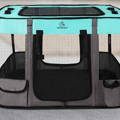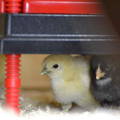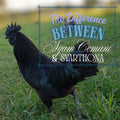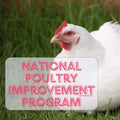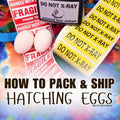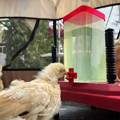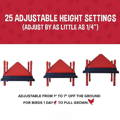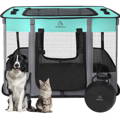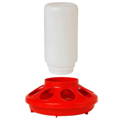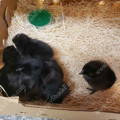
Poultry Brooder Essentials: Get Set-Up Before They Show Up.
Chick brooding is a crucial aspect of raising healthy and productive poultry. During the brooding phase, chicks require specific items to ensure their well-being and support their growth and development. Providing these essential items is key to creating a suitable environment for the chicks and promoting their welfare. Let's explore the necessary items for successful chick brooding.
FUN FACT: One of the best things to feed baby chicks is scrambled eggs.
Subscribe
To join our mailing list and never miss an update!
Being in the business of hatching, we have learned through trial and error which products work best for this phase of a chicken’s life. Although there are many other items you can add to your brooding equipment list, these are the essential items we recommend and use in our own brooder at Gypsy Shoals Farm. Links to all products are available at the bottom of this article.
1. Brooder Box or Space
Creating a safe and spacious brooding area is crucial to protect the chicks from household pets and other potential hazards. A brooder box or a designated part of the coop should be set up with adequate space for the chicks to move around freely.
The brooding area should also be well-ventilated while offering protection from extreme weather conditions. You will find that a dog crate or doggie playpen will meet these needs perfectly. They are easy to clean and the top cover keeps your chicks from escaping once they begin stretching their wings and attempting to fly.
2. Heat Source and Temperature Control
Chicks are unable to regulate their body temperature until they shed their down and grow feathers. A heat source is vital for their survival. A brooder heater is commonly used to provide warmth in the brooding area. Heat lamps are NOT a good solution because of the very real fire danger they present. A chick brooder heating plate provides the warmth baby chicks need without the fire danger.
With adjustable legs, a brooder heating plate allows you to raise or lower the warmth as your chicks grow. An additional benefit to using a heating plate is the ability for chicks to escape the heat if they are too hot by simply walking out from under it. Baby chicks will tell you if they are too hot or too cold. Quiet chicks are happy and content chicks.
3. Bedding or Flooring
Choosing the right bedding or flooring for the brooder is important to maintain hygiene, promote good health, and prevent diseases. Common options for bedding include wood shavings, straw, or paper products, but the best bedding is simple puppy pads. Choose a size that fits the dimensions of your brooder box and change it at least once a day.
Puppy pads make keeping the brooder clean a breeze. No wood shavings to scrape out into a dust pan. No soggy paper bedding to clean up. Simply roll up the dirty one, toss it and replace it with a new one.
Puppy pads also assist in preventing splayed leg and curled toes that can develop if baby chicks are kept on a slick surface such as plastic. Whatever you choose, the bedding material should have good absorbency, be easy to clean, and provide a comfortable surface for the chicks to rest and move around on.
4. Feeder and Waterer
Chicks require access to fresh water and feed at all times. Proper hydration and nutrition are crucial for their growth and development. Invest in a waterer specifically designed for chicks with a shallow dish, or use a chick-sized poultry nipple waterer that prevents drowning. A nipple waterer ensures clean water is available because baby chicks are unable to walk through it.
Similarly, choose a small-sized feeder that enables the chicks to access their feed easily. Choose a poultry feeder that is segmented with holes to access the feed. Chicks will naturally scratch and peck. If you feed them out of a regular bowl, they will create a great deal of waste and cost a great deal more in feed as a result.
Your baby chicks won’t eat much the first few days after hatch. This is because they already have full bellies! Before hatching, the chick ingests the yolk which contains the vital nutrition to sustain them for 24-72 hours after hatching. Ensure that the waterer and feeder are kept clean and refilled regularly to provide a constant supply of fresh food and water.
Trending Articles
5. Chick Starter Feed
Whether you choose to use medicated or non-medicated chick starter, baby chicks should not be fed adult poultry feed. Baby chicks have different nutritional requirements than adult poultry. The nutrition provided in chick starter feed meets the demands of their fast-growing bodies to ensure strong healthy bones and vital development.
The best thing to provide baby chicks in the first few days of life is scrambled eggs. As morbid as this sounds when you stop and think about it, a chicken egg contains all the nutrition, vitamins and minerals that baby chicks need to thrive.
6. Brooder Light (non-heat)
If you are using a brooder box that is relatively dark inside of if your brooder box is located in a dark room, you will need to provide a brooder light. This is not a heat lamp. A brooder light serves to simulate natural daylight and helps establish a regular day-night cycle for the chicks.
The light should be set on a timer, initially providing around 24 hours of continuous light and gradually reducing it to 18 hours a day. This mimics the natural daylight patterns and supports the chicks' healthy growth and development.
7. Medical Supplies
Before your baby chicks hatch, have these supplies on hand to address any medical situations that may arise during or after hatch.
• self-adhesive wrap bandage (smallest width possible)
• Vetericyn Antimicrobial Spray
• tweezers
• surgical scissors
• poultry electrolytes and probiotics
In conclusion, providing the necessary items for chick brooding is fundamental to their wellbeing and growth. By ensuring a suitable heat source, brooder box, bedding, feeders, waterers, brooder guard, lighting, and monitoring tools, you can create a supportive environment for chicks to thrive. Proper brooding sets the stage for healthy and productive poultry, laying the foundation for their future success.
Poultry Brooder Shopping List
• portable and collapsible dog crate
• 12x12 poultry brooder warming plate
• puppy pads (various sizes)
• medicated chick starter or non-medicated chick starter
• self-adhesive wrap bandage (can be cut smaller)
• Vetericyn Plus Antimicrobial Spray
• tweezers and surgical scissors
Copyright©2023 All rights reserved. We love to have you share our article as long as you include a direct link to this page. Please contact us for permission and we’ll be happy to collaborate. This article or any portion thereof , including all images, may not be reproduced or used in any manner whatsoever without the express written permission of Gypsy Shoals Farm.

